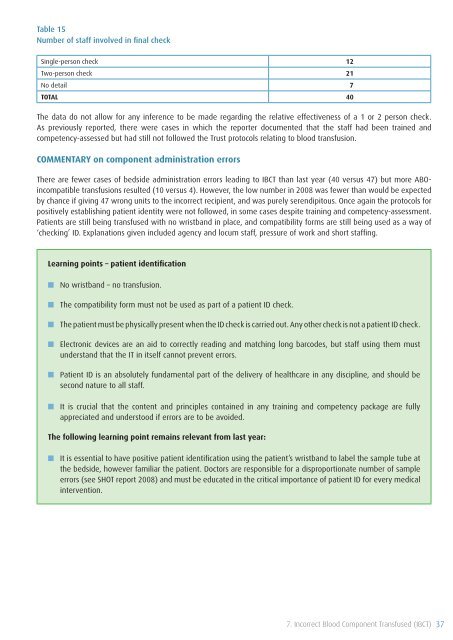SHOT Annual Report 2009 - Serious Hazards of Transfusion
SHOT Annual Report 2009 - Serious Hazards of Transfusion
SHOT Annual Report 2009 - Serious Hazards of Transfusion
You also want an ePaper? Increase the reach of your titles
YUMPU automatically turns print PDFs into web optimized ePapers that Google loves.
Table 15<br />
Number <strong>of</strong> staff involved in final check<br />
Single-person check 12<br />
Two-person check 21<br />
No detail 7<br />
TOTAL 40<br />
The data do not allow for any inference to be made regarding the relative effectiveness <strong>of</strong> a 1 or 2 person check.<br />
As previously reported, there were cases in which the reporter documented that the staff had been trained and<br />
competency-assessed but had still not followed the Trust protocols relating to blood transfusion.<br />
COMMENTARY on component administration errors<br />
There are fewer cases <strong>of</strong> bedside administration errors leading to IBCT than last year (40 versus 47) but more ABOincompatible<br />
transfusions resulted (10 versus 4). However, the low number in 2008 was fewer than would be expected<br />
by chance if giving 47 wrong units to the incorrect recipient, and was purely serendipitous. Once again the protocols for<br />
positively establishing patient identity were not followed, in some cases despite training and competency-assessment.<br />
Patients are still being transfused with no wristband in place, and compatibility forms are still being used as a way <strong>of</strong><br />
‘checking’ ID. Explanations given included agency and locum staff, pressure <strong>of</strong> work and short staffing.<br />
Learning points – patient identification<br />
■■<br />
■■<br />
■■<br />
■■<br />
■■<br />
■■<br />
No wristband – no transfusion.<br />
The compatibility form must not be used as part <strong>of</strong> a patient ID check.<br />
The patient must be physically present when the ID check is carried out. Any other check is not a patient ID check.<br />
Electronic devices are an aid to correctly reading and matching long barcodes, but staff using them must<br />
understand that the IT in itself cannot prevent errors.<br />
Patient ID is an absolutely fundamental part <strong>of</strong> the delivery <strong>of</strong> healthcare in any discipline, and should be<br />
second nature to all staff.<br />
It is crucial that the content and principles contained in any training and competency package are fully<br />
appreciated and understood if errors are to be avoided.<br />
The following learning point remains relevant from last year:<br />
■■ It is essential to have positive patient identification using the patient’s wristband to label the sample tube at<br />
the bedside, however familiar the patient. Doctors are responsible for a disproportionate number <strong>of</strong> sample<br />
errors (see <strong>SHOT</strong> report 2008) and must be educated in the critical importance <strong>of</strong> patient ID for every medical<br />
intervention.<br />
7. Incorrect Blood Component Transfused (IBCT) 37












